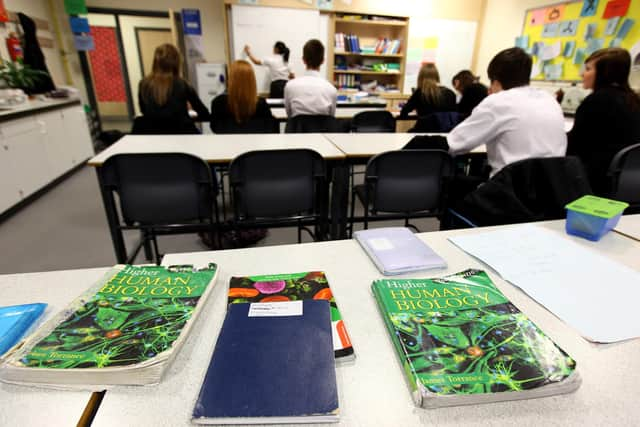Scottish schools are struggling amid ‘tidal wave’ of badly behaved, aggressive pupils and 'mob rule' in some classrooms' – Cameron Wyllie
At the end of last week, it was widely reported in the press that three teachers and a 14-year-old pupil had been injured at Johnstone High School in Renfrewshire after a former pupil entered the premises. Whatever the circumstances of that incident, as we see repeatedly in the USA, where the consequences are often grievously tragic, schools can have deranged students or former students who carry out attacks, for reasons real or imagined. I fear that, as things stand, we will see more of this kind of incident in Scotland.
But there were two further interesting things about this nasty event, based on comments made by parents and pupils at the school after it occurred. The first was that violence and vandalism had been increasing in the school for months, to the extent, it seems, that the toilets, having been repeatedly damaged, were now “permanently closed” (I’m quoting from media reports here, but that seems very extreme – I would have thought that a school with no pupil toilets would just have to shut until they were repaired but perhaps they have put in temporary facilities).
Advertisement
Hide AdAdvertisement
Hide AdThe second, which was heartening, was that the school community was full of praise for the headteacher, whom, it was felt, was doing an excellent job in very difficult circumstances. It’s great to see a situation in which students and their parents, and the staff of the school don’t immediately blame senior managers for its woes. However, if – and let’s just accept this – those working in the school are doing their level best to deal with the minority (and it will be a tiny minority) of young people who are creating this destructive and aggressive environment, then what’s to be done to help them get the school back to the calm and orderly state necessary for effective education?
The Renfrewshire incident took place on the same day that the NASUWT union said that, since the pandemic, there had been a big increase in challenging behaviour in schools. Similarly, Scotland’s biggest teaching union, the EIS, has commented on the increase in violent incidents in schools. But in the most pointed intervention, the president of the Scottish Secondary Teachers’ Association, Catherine Nicol, addressing the union’s conference this past weekend, spoke at length about the “elephant in the room” for Scottish teachers being the “tidal wave of distressed behaviours” which has hit Scottish secondary classrooms (though it should be said these issues are creeping further and further down in our primary schools too).
"Distressed behaviours” struck me as the kind of thoughtful euphemism which is becoming increasingly common in Scottish education. It usually means really bad behaviour, often aggressive, which increasingly disrupts education in the classroom. Ms Nicol went on to say that some pupils are rude, disrespectful and selfish, crave attention and simply refuse to do tasks that they don’t want to do. She went on: “At worst, mob rule prevails in classrooms and corridors. In many schools, teachers are faced with torrents of verbal abuse during lessons. The number of reported violent incidents is increasing.”
Now, to anyone educated in a Scottish school before say, the end of the millennium, all this must seem shocking, if not unbelievable. How has this state of affairs come about? What are schools doing about it? What powers do they have? And more pointedly for Jenny Gilruth, the newly appointed Cabinet Secretary for Education and Skills, who was, to her credit, sitting in the hall listening to this, what is the Scottish Government proposing to do?
You see, everyone is a victim here, including, very often, the young people creating this terrible environment, who simply shouldn’t be there. But mostly let’s consider also the feelings of the vast majority of school pupils, blameless, hard-working, often actually interested in the lesson and its potential for their future. Another period of maths gone because the teacher is outside the classroom trying to talk sense into some wee thug who terrorises other kids at break too. If there’s 28 in that class, every minute the teacher is outside is 27 minutes of class time wasted. Eventually, some of the good guys and girls get so intimidated they won’t go to school. Their own mental health is affected by the issues of other violent, abusive pupils who require care well beyond the scope and budget of a mainstream school.


So, two suggestions: that, in the light of three of Scotland’s teaching unions raising this, Jenny Gilruth urgently re-examines the “presumption of mainstreaming” all pupils – recently described to me by the deputy head of an urban state school as a “disaster”. We need far greater individualisation of treatment of young people who, for whatever reason, can’t control their behaviour.
And secondly, if that doesn’t happen – and to be honest, my breath is far from held – the unions must consider what action they need to take to protect their members. We have just been through a period of industrial action that shut schools, which resulted in a tolerable and entirely justified pay deal for Scottish schoolteachers. But surely personal safety and job satisfaction – as well as the need to ensure that actual teaching is always taking place in every classroom – should command at least as much interest in the minds of union leaders.
Cameron Wyllie writes a blog called A House in Joppa. His book, Is There A Pigeon in the Room? My Life in Schools, is published by Birlinn.